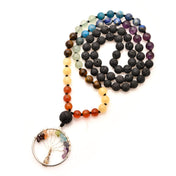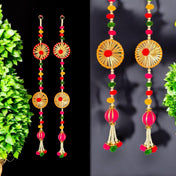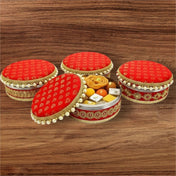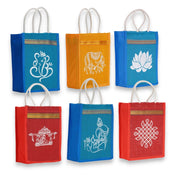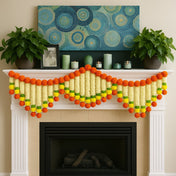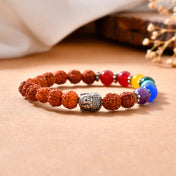The Importance of Pooja Samagri in Hindu Home Worship
Creating a sacred space for worship in your home begins with gathering the right pooja samagri—the essential items used in Hindu religious ceremonies. These sacred tools act as bridges between the physical and spiritual realms, helping devotees connect with their chosen deities.
Think of pooja samagri as your spiritual toolkit, where each item carries deep symbolic meaning and serves a unique purpose in daily rituals. From the gentle flicker of a diya to the soothing fragrance of incense, these sacred elements come together to create an atmosphere of divine presence and serenity.
What makes pooja samagri so vital?
- Creates an authentic worship experience
- Helps maintain traditional Hindu practices
- Establishes a dedicated sacred space
- Deepens your spiritual connection
- Brings structure to your daily prayers
Essential Pooja Items
To transform your home worship experience, it's crucial to understand the essential pooja items you'll need, their significance, and how to use them properly. Here are some sacred tools that have been cherished in Hindu homes for generations:
- Deity Idols: Items like gold plated Laxmi Ganesha Radha Krishna idols serve as focal points during worship.
- Backdrops for Pooja: An Elephant Ganesha backdrop or a Radha Krishna with peacock backdrop can enhance the aesthetic appeal of your worship space.
- Decorative Serving Bowls: A hammered copper plating dryfruits jar can be used during rituals or as return gifts for special occasions.
- Comfortable Bedding: While not directly related to pooja samagri, having a comfortable resting space is important. Consider using 100% cotton sheets for a good night's sleep after a long day of rituals.

Understanding the Importance of Pooja Samagri
Pooja samagri refers to a sacred collection of items used in Hindu worship rituals, each carrying deep spiritual significance passed down through generations. These divine tools serve as a bridge between the physical and spiritual realms, fostering an atmosphere ideal for deep meditation and prayer.
The Historical Origins of Pooja Samagri
The origins of pooja samagri date back to ancient Vedic times when sages meticulously recorded the use of specific items for various religious ceremonies. These sacred texts describe how each element carries unique vibrational energies that enhance the power of prayers and mantras.
Key Aspects of Pooja Samagri in Hindu Culture
Here are some key aspects that highlight the significance of pooja samagri in Hindu culture:
- Sacred Symbolism: Each item represents specific divine attributes - fire symbolizes transformation, water signifies purification.
- Energy Activation: The combination of different materials creates powerful energy fields that enhance spiritual practices.
- Divine Connection: Physical objects serve as focal points to channel devotion and establish a stronger bond with deities.
- Sensory Engagement: Items engage all five senses - sight, sound, touch, smell, and taste - creating an immersive spiritual experience.
Transforming Space with Pooja Samagri
The thoughtful selection and arrangement of pooja samagri can transform an ordinary space into a sacred sanctuary. As devotees engage with these blessed items during rituals, they attain a heightened state of consciousness, allowing their prayers to become more focused and meaningful.
Consider pooja samagri as spiritual tools that help align your inner energy with divine vibrations—much like how musical instruments require proper tuning to produce harmonious melodies.
Enhancing Your Pooja Experience
To enhance your pooja experience, consider incorporating some unique items such as:
- Handcrafted wooden printing stamps used for crafting Indian textiles.
- A banana leaf backdrop which can serve as a beautiful decorative element during rituals.
- Antique gold plated South Indian bangles or CZ nose ring for those special occasions.
- A Ganesha print jute bag for carrying pooja samagri not only adds a personal touch but also promotes eco-friendliness.
1. Deity Idols or Pictures
The essence of any Hindu puja altar lies in its deity representations, which serve as focal points for devotion and create a direct channel for spiritual connection.
Popular Deities for Home Worship:
- Lord Ganesha – The remover of obstacles, bringing wisdom and success.
- Goddess Lakshmi – The divine mother of prosperity and abundance.
- Lord Krishna – The embodiment of love and divine consciousness.
- Goddess Saraswati – The bestower of knowledge and artistic talents.
Selecting Your Deity Representation:
- Choose deities that align with your spiritual journey.
- Consider your family's traditional Kula Devata (family deity).
- Opt for durable materials like brass, copper, or silver.
- For picture alternatives, select high-quality framed prints.
Care and Maintenance Tips:
- Clean idols daily with fresh water.
- Use a soft cloth for gentle dusting.
- Place them in an elevated, respectful position.
- Keep separate cloths for cleaning ritual purposes.
- Avoid direct sunlight to prevent fading.
Always handle deity representations with reverence, as they are not just decorative items but sacred embodiments of divine energy within your home.
In addition to the idols or pictures, you may also want to incorporate items like a Mindhol rumal, which is traditionally used in rituals and can enhance the spiritual ambiance of your puja space.
2. Pooja Thali
A pooja thali is a sacred plate that holds all the important items for your daily worship rituals. These decorative plates come in different materials, each with its own spiritual meaning:
- Brass Thalis: Known for their strength and ability to conduct positive energy
- Silver Thalis: Symbolize purity and are believed to enhance the power of offerings. The charm of silver extends beyond pooja thalis, also encompassing jewelry such as silver toe rings.
- Copper Thalis: Valued for their ability to kill germs and promote healing
- Bronze Thalis: A traditional choice that combines durability with visual appeal

What Does a Pooja Thali Include?
A well-prepared pooja thali typically includes:
- Roli (vermillion) holder
- Kumkum container
- Small diya
- Akshata (rice) container
- Space for incense holder
- Water container
- Bell
- Flower holder
The designs on these thalis often showcase intricate patterns inspired by Hindu mythology—such as lotus motifs symbolizing purity and peacock designs representing divine beauty. Many thalis also feature raised edges to prevent items from slipping during rituals and include designated compartments for efficient organization of pooja essentials.
How to Choose the Right Pooja Thali?
When selecting your pooja thali, consider the size of your altar space and the number of items you regularly use in your daily rituals. A 8-12 inch diameter thali works well for most home worship settings.
Additionally, you might want to complement your pooja setup with items like a personalized candle holder or an artistic Indian bracelet box, which can add a unique touch to your decor while also serving a practical purpose in storing jewelry or other small items. Furthermore, if you're preparing for special occasions like Navratri or Durga Pooja, consider using a traditional cloth backdrop like the Indian Durga Mata backdrop, which can significantly enhance the ambiance of your pooja space.
3. Diya (Lamp)
The sacred diya lights the divine path in Hindu worship, symbolizing the victory of light over darkness and knowledge over ignorance. This traditional oil lamp carries deep spiritual significance, serving as a bridge between the earthly and divine realms.
Types of Diyas and Their Meanings:
- Brass Diyas - Represent purity and prosperity
- Clay Diyas - Symbolize connection to earth elements
- Silver Diyas - Signify lunar energy and peace
- Copper Diyas - Associated with healing properties
The placement of diyas during puja carries specific meanings:
- Center of altar - Main offering to the deity
- Four corners - Protection from negative energies
- Doorway - Welcome divine blessings
The flame of a diya should ideally burn steadily and brightly, always pointing upward. Traditional wicks made from cotton are soaked in pure ghee or sesame oil, though modern alternatives include vegetable oils. A properly lit diya enhances the spiritual atmosphere, helping devotees focus their prayers and meditation.
The number of diyas lit varies depending on the ritual—a single diya for daily worship, five diyas for special occasions, and multiple rows during festivals like Diwali to amplify the divine energy.
For instance, a peacock deepam brass finish diya is often used during such festive occasions to enhance the spiritual ambiance.
4. Incense Sticks (Agarbatti)
The soft, fragrant smoke of agarbatti (incense sticks) creates a peaceful and sacred atmosphere during Hindu worship. These aromatic sticks help purify the space and uplift the mind, making it easier to focus on prayers.
Common Incense Scents and Their Meanings:
- Sandalwood – Brings calmness, perfect for meditation.
- Jasmine – Attracts positive energy and blessings.
- Rose – Symbolizes love and devotion to deities.
- Lotus – Represents purity and spiritual growth.
- Champa – Helps improve concentration during prayers.
The smoke from incense is believed to carry prayers to the heavens. According to tradition, it’s best to light incense in a clockwise direction so the fragrance spreads naturally.
Simple Tips for Using Incense:
- Place the incense holder to the right of your deity.
- Light it at the start of your puja to set the mood.
- Choose natural, chemical-free incense for a pure experience.
- Store in a dry place to keep the fragrance fresh.
5. Kalash (Sacred Pot)
The kalash is a powerful symbol of abundance, prosperity, and spiritual purity in Hindu worship. This sacred pot, traditionally made of copper, brass, or silver, represents the divine presence of Mother Earth and the cosmic elements.
Traditional Kalash Setup
A traditional kalash setup includes:
- A metal pot with a wide base and narrow neck
- Fresh water or Gangajal (holy water)
- Mango or betel leaves
- A coconut wrapped in red thread
- Flowers and durva grass
- Coins or rice grains
Symbolic Meaning of Kalash Elements
Each element in the kalash carries deep spiritual significance:
- Water – Represents the life force and purity.
- Coconut – Symbolizes divine consciousness.
- Leaves – Signify nature’s blessings.
- Flowers – Embody devotion and beauty.
Role of Kalash in Rituals
During rituals, the kalash is placed at the center of the altar as a focal point of worship. Many Hindu homes keep a permanent kalash, believing it brings positive energy and divine protection. The water inside is considered sacred and is often used to bless family members or sprinkled during special ceremonies.
Choosing the Right Size Kalash
The size of your kalash can be chosen based on the available space and the requirements of the ritual. Smaller kalash setups are ideal for daily home worship, while larger ones are more suitable for special occasions and festivals.
Enhancing Rituals with Personalized Gifts
Incorporating elements like personalized gifts into these rituals can further enhance their significance. For instance, gifting a personalized Diwali gifts hamper that includes items such as an acrylic rangoli with tea light candles can add a unique touch to the celebration.
6. Bell (Ghanta)
The sacred ghanta (bell) is a powerful instrument in Hindu worship, producing vibrations that dispel negative energies and strengthen the connection to the divine. Its resonating sound serves to:
- Notify deities of the devotee’s presence.
- Bridge the gap between the earthly and celestial realms.
- Create a protective energy field during worship.
Traditionally made of brass or bronze, the bell often features intricate designs, sacred symbols, and a vajra (thunderbolt) handle. It is rung at key moments during puja rituals, including:
- Before beginning the ceremony
- While performing aarti
- During mantra recitation
- When offering prasadam to deities
Proper Placement:
Place the bell on the right side of your altar, ensuring it is within easy reach during worship. To maintain its sanctity, rest it on a small wooden or metal stand, preventing direct contact with the ground.
Did you know? The specific rhythm and timing of bell-ringing varies across different Hindu traditions, with some practices requiring continuous ringing while others call for precise intervals.
7. Roli-Chawal (Colored Powder and Rice)
Roli (red vermillion powder) and chawal (uncooked rice) are important parts of Hindu worship. They have deep spiritual meaning and are mainly used for applying tilak—the sacred mark placed on deities and devotees during rituals.
This practice is often observed during special occasions like Raksha Bandhan, where rakhis are exchanged and roli with chawal are incorporated into the rituals.
Sacred Application Process:
- Mix roli with a few drops of water to create a paste
- Place rice grains in a small silver or brass container
- Apply roli tilak first, followed by rice grains
- Use your ring finger for deity offerings
- Place with devotion and pure intentions
Natural Disposal Methods:
- Collect used roli-chawal in a clean container
- Sprinkle in your garden or near sacred plants
- Release into flowing water bodies
- Add to the base of a Tulsi plant
- Never dispose in garbage bins
The red color of roli represents divine feminine energy, while rice symbolizes prosperity and abundance. Together, they form a sacred offering, allowing devotees to connect with the divine through the traditional practice of tilak application.
8. Puja Asan (Prayer Mat)
A Puja Asan is a sacred mat used for seating during worship. It creates a spiritual boundary between you and the ground, symbolizing the shift from the ordinary world to a divine space.
Traditional Puja Asans come in various materials:
- Cotton: Lightweight and washable, perfect for daily use
- Silk: Luxurious and often adorned with intricate designs
- Wool: Provides warmth and comfort during extended prayer sessions
- Kusha Grass: Considered highly sacred, believed to purify the surrounding energy

The designs reflect rich cultural diversity across different regions:
- North Indian styles feature geometric patterns and peacock motifs
- South Indian variations incorporate temple borders and lotus designs
- Bengali traditions prefer simple white cotton asans with red borders
- Gujarati styles showcase vibrant mirror work and embroidery
Your Puja Asan's size should allow comfortable seating in cross-legged position, typically measuring 2x2 feet. Many devotees personalize their prayer mats with sacred symbols or mantras, creating a deeper connection to their spiritual practice.
During festivals like Navratri, it's common to decorate your home with items such as happy Navratri cutout signs featuring Mata faces. These decorations not only enhance the festive spirit but also serve as a beautiful backdrop for your puja rituals.
9. Shankh (Conch Shell)
The sacred shankh (conch shell) carries divine energy in Hindu rituals, producing powerful vibrations that purify the surroundings. Its spiral shape holds deep spiritual significance, representing the cosmic sound "Om", the primordial vibration of creation.
Significance of the Shankh in Worship:
- Generates sacred sound vibrations that dispel negative energies.
- Marks the beginning and end of religious ceremonies.
- Symbolizes victory and prosperity in Hindu mythology.
- Used as a musical instrument in temple rituals.
Tips for Blowing the Shankh:
- Clean it with warm water and dry thoroughly.
- Place your lips at the small end and create a tight seal.
- Take a deep breath and blow steadily through pursed lips.
- Practice breath control for a sustained sound.
- Start with short bursts before attempting longer tones.
Sacred Care Ritual:
When not in use, keep the shankh on a clean cloth and pour a small amount of holy water inside after each ceremony. Many devotees adorn their shankh with silver or gold decorations to enhance its sacred beauty.
10. Bhog-Prasad (Food Offerings and Blessed Food)
Bhog-prasad is the sacred food offered to deities during Hindu worship, transforming ordinary food into divine blessings. Each deity has specific preferences for offerings:
Food Offerings for Deities:
Lord Ganesha:
- Modak (sweet dumplings)
- Fresh fruits
- Besan or coconut laddoos
Goddess Lakshmi:
- Kheer (rice pudding)
- Yellow-colored sweets
- Fresh fruits, especially bananas
Lord Krishna:
- Butter and dairy products
- Makhan mishri (sweetened butter)
- Panchamrit (a mixture of five sacred ingredients)
Guidelines for Preparing Prasad:
- Clean the kitchen before cooking.
- Take a bath and wear fresh clothes.
- Chant mantras while preparing the food.
- Do not taste the food before offering it to the deity.
The True Essence of Bhog-Prasad:
The most important ingredient in bhog-prasad is love and devotion. Once the deity has been offered the food, it is distributed among family members and guests as a blessed offering.
During festive seasons like Diwali, which is known as the festival of lights, it's common to incorporate these offerings into the celebrations. You can even capture these precious moments with Diwali photo booth props that add a fun element to your celebrations!
11. Decorative Items for Your Puja Space
The aesthetic elements of your puja space create a sacred atmosphere that uplifts your spiritual experience. Traditional decorative items carry deep symbolic meanings while adding beauty to your worship area.
Torans (Door Hangings)
- Brass or copper torans - Traditional metallic hangings featuring auspicious symbols
- Fabric torans - Handcrafted with mirrors, beads, and embroidery
- Fresh flower torans - Made daily using marigolds, roses, or jasmine. You can even opt for artificial marigold flowers that offer a lasting charm.
- Mango leaf torans - Natural green decorations symbolizing fertility and life
Rangoli Designs
Create intricate patterns using:
- Colored rice powder
- Natural flower petals
- Vibrant colored sand
- Traditional kumkum powder
Additional Decorative Elements
- Fresh flowers in small vases
- Decorative cloth or silk for altar backdrop
- Brass or silver kalash with coconut and mango leaves
- Crystal or brass deepak stands
- Handcrafted wooden pedestals for deity idols
DIY Decoration Ideas
- String together fresh jasmine flowers for garlands
- Create lotus designs using rose petals
- Paint diyas with natural colors and traditional motifs
- Arrange floating flowers in a brass urli
- Make patterns using turmeric and kumkum powder
These sacred decorations transform your puja space into a divine sanctuary, helping you connect deeper with your spiritual practice. You might also consider incorporating unique decorative items such as antique dancing lady door pull handles for your doors to add an artistic touch.
Additionally, meditation singing bowl sets can enhance your spiritual practice by providing calming sounds during meditation. Lastly, if you're looking for personalized gifts or custom work ideas, explore some gifting ideas that could be perfect for housewarming or festive occasions.
12. Japa Mala (Meditation Beads)
The Japa Mala is a sacred meditation tool in Hinduism, consisting of 108 beads strung in a specific pattern. Each bead represents a step in the spiritual journey, helping practitioners focus during mantra recitation and deep meditation.
Traditional Materials for Japa Mala:
- Rudraksha Seeds – Believed to carry Lord Shiva’s blessings.
- Sandalwood – Known for its calming effect and soothing fragrance.
- Crystal Beads – Different crystals provide unique spiritual benefits.
- Tulsi Wood – Associated with Lord Krishna and purification.
- Bodhi Seeds – Linked to wisdom and enlightenment.
How to Use a Japa Mala:
- Hold the mala in your right hand.
- Use your thumb to count each bead.
- Do not cross over the guru bead (the larger, central bead).
- Move the beads toward you while chanting.
The bead size plays a role—larger beads improve focus during long meditation sessions, while smaller ones are easier to carry for daily use. Trust your intuition when selecting a mala that resonates with your spiritual journey.
Care Tips:
- Store in a clean silk or cotton pouch.
- Keep away from direct sunlight.
- Cleanse periodically under moonlight.
- Handle with respect and devotion.
With regular use, your Japa Mala absorbs the energy of your mantras, strengthening your spiritual connection.
Japa Mala and Navratri’s Golu Display:
Incorporating a Japa Mala into your daily practice can also complement other spiritual traditions, like setting up a Golu display during Navratri. Just as the Golu arrangement reflects devotion and creativity, using a Japa Mala fosters a personal spiritual bond through meditation and mantra chanting.
Maintaining Your Pooja Samagri: Care Tips for Longevity
Your sacred pooja items deserve special attention to maintain their spiritual energy and physical condition. Here's how to keep your pooja samagri in pristine condition:
Daily Care Practices:
- Dust your deity idols with a soft cloth
- Clean the pooja thali after each use
- Wash and dry the kalash regularly
- Empty and clean used diyas
Weekly Maintenance:
- Polish brass and copper items with lemon and salt
- Clean silver items with specialized silver polish
- Wash fabric items like asan and cloths
- Replace old incense ash with fresh sand
Storage Guidelines:
- Keep items in a dry, clean space
- Store delicate items wrapped in soft cloth
- Place wooden items away from direct sunlight
- Protect metal items from moisture
Special Care Tips:
- Deity Idols: Use gentle cleaning methods appropriate for the material
- Shankh: Clean with salt water and dry thoroughly
- Japa Mala: Store in a cotton pouch
- Bells: Apply oil periodically to maintain sound quality
Sacred Handling:
- Touch items with clean hands
- Keep separate cleaning materials for pooja items
- Handle with reverence and mindfulness
- Consider periodic spiritual cleansing with Gangajal
These care practices help preserve both the physical integrity and spiritual essence of your pooja samagri, ensuring they serve you well in your devotional practices for years to come.












